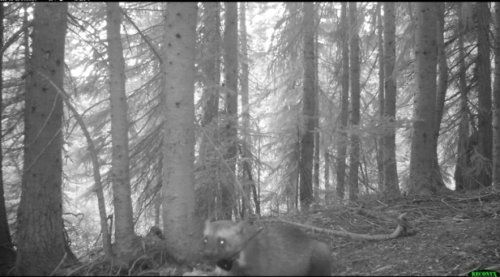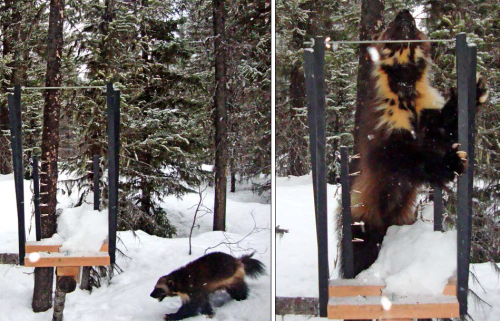Wolverines: A Natural History

By Tyler Davis, graduate student of the Institute’s 15th cohort.
Wolverines are elusive creatures that are primarily found in the far reaches of wilderness areas. These animals are symbols of the wild, strong and seemingly fearless. They are also a source of fear stemmed from misunderstandings. Sadly, there is still a lack of knowledge about the behaviors and needs of wolverines; however, natural resource managers are now trying to find the best ways to enable wolverine survival through behavior, distribution, and needs assessment studies. There are still important things we have to learn in order to better understand this animal, but with the relatively recent increase in wolverine research, there are some incredibly important pieces of information that should be considered.
Gulo gulo, which translates to glutton glutton, was the Latin name given to wolverines by Linnaeus. They are the largest land dwelling member of the Mustelid, or weasel, family. These animals are built to survive in winter dominated climates. With their Latin name in mind, one might not be surprised to find out that these wolverines have one of the strongest jaws in the world.
Their strong jaws enable them to rip meat off carcasses, even when frozen, and they can crush through bone in just one bite. This is not to say that wolverines are mindless savages, eating whatever comes their way. In fact, they are highly intelligent creatures. They have even been known to stand on their back legs using one of their paws to shield their eyes from the sun while scanning an area.

Wolverines are located across the globe in a circumpolar pattern, with presence in places that maintain spring snow pack, which is necessary for denning. Currently, there are confirmed populations in the following countries: Norway, Sweden, Finland, Russia, Canada, and the United States. Within the U.S., wolverines are limited to the North Cascades of Washington, Oregon, northern and central Idaho, western Montana, northwestern Wyoming, and Alaska.
As for the present status of the wolverines in the North Cascades of Washington, specifically, there has been a recent effort to study the ecology and distribution of this population. This research is important because this population, which is the furthest south of any current wolverine ranges on the Pacific coast of North America, has never been studied before. The study took place primarily in the North Cascade Range of Washington, but it soon became apparent that the population may include parts of Canada; collaborative research began in British Columbia during the fourth year of the study.
Over the course of the study, 14 wolverines were captured and studied. Five of the 14 were studied over multiple years and two additional individuals were caught on camera. This means that 16 animals were accounted for during the study and 14 of these animals were monitored. In order to take appropriate conservation measures to protect wolverines in the area, we need to learn more about them, which is why continued research is essential.
One recent decision regarding wolverines that has been a point of debate is that of the proposal for the species being listed as threatened under the Endangered Species Act, which would provide forms of protection for the animal. This was first proposed by the U.S. Fish and Wildlife Service (USFWS) in 2013, but they withdrew their proposal the following year. The original reason they gave for listing the species was that the warming climate will likely lead to major reductions in suitable wolverine habitat, therefore, the survival of the species is uncertain. However, when withdrawing their proposal, they stated that the science was not conclusive. This decision can certainly have far reaching impacts on gulos in the U.S., making it an important issue to be aware of. Continued research will provide further evidence that may make the case for protection of this species.
In conclusion, scientists have learned a great deal about wolverines, especially in recent years. There are still a number of things that we need to know if we want to protect and generally act in the best interest of this species. With changes in climate and increased human populations, it is important that we start considering the impacts that these animals might be facing. Let’s keep this symbol of the wild alive. Indeed, Gulo gulos have proven to be resilient creatures in the past and I see no reason that should change now.

